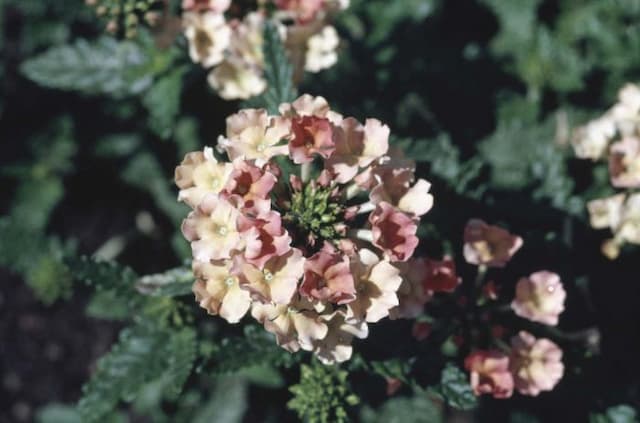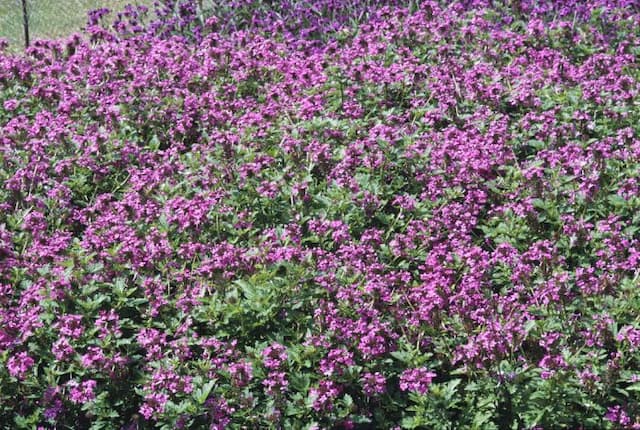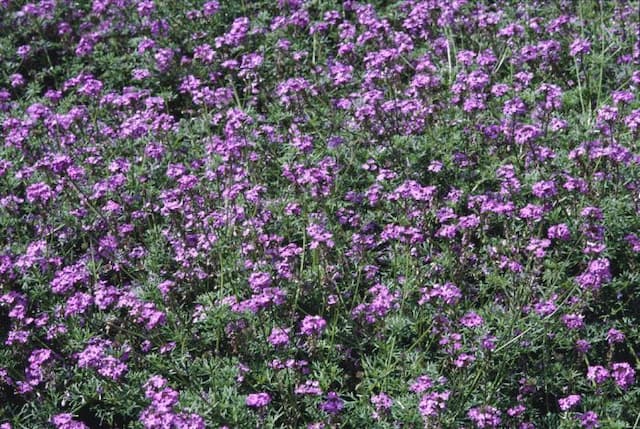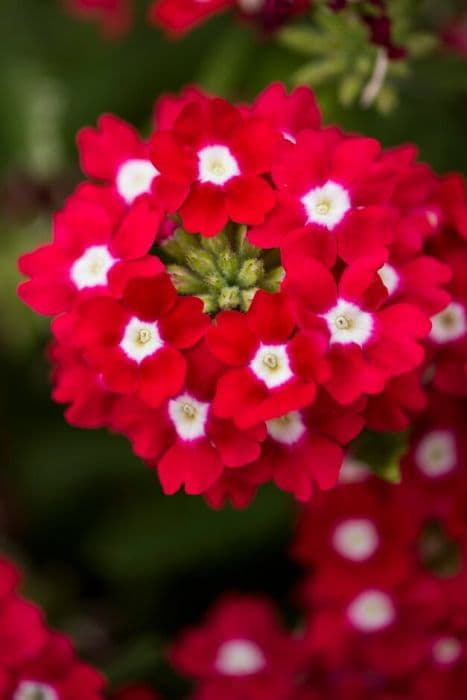Purpletop Vervain Verbena bonariensis

ABOUT
Verbena bonariensis, often known as the purpletop vervain, is a striking ornamental plant notable for its airy and delicate appearance. This plant typically features a cluster of small, tubular flowers that exude a vivid lavender to purple hue. These flowers are grouped into round or slightly flattened heads that attract a variety of pollinators including butterflies and bees. The flowering heads are held aloft by thin, wiry stems that are largely bare of foliage, giving the plant a loose and open structure that allows for movement in the breeze. The stems are a blend of green and reddish tones, adding to the plant's visual interest. Leaves of the purpletop vervain are predominantly located toward the base of the plant, with a few scattered up the stems. These leaves are narrow and elongated, with slightly serrated edges, and exhibit a deep green color that contrasts nicely with the purple flowers. The overall impression of Verbena bonariensis is one of a light and airy plant that adds both color and a sense of vertical layering to garden spaces without being overpowering. Its charm lies in its slender form and the small yet vibrant clusters of flowers that seem to hover like a purple haze above the rest of the planting.
About this plant
 Names
NamesFamily
Verbenaceae.
Synonyms
Purpletop Vervain, Tall Verbena, Brazilian Vervain, South American Vervain, Clustertop Vervain, Pretty Verbena, Purpletop.
Common names
Verbena bonariensis var. conglomerata Briq., Verbena bonariensis var. patagonica Moldenke, Verbena bonariensis f. albiflora Moldenke, Verbena bonariensis var. bonariensis, Verbena bonariensis var. ampla Briq., Verbena bonariensis var. lilacina Moldenke, Verbena bonariensis var. prostrata Moldenke, Verbena brasiliensis Vell., Verbena incompta P. W. Michael, Verbena incompta var. typica Moldenke.
 Toxicity
ToxicityTo humans
Tall verbena is not commonly recognized as a toxic plant to humans, and there are no significant reports of poisoning from ingestion. Nevertheless, it is always advisable to exercise caution and not consume parts of ornamental plants unless they are known to be edible, as they may cause gastrointestinal discomfort or allergic reactions in sensitive individuals.
To pets
Tall verbena is generally not considered toxic to pets. However, as with humans, it is prudent to prevent pets from ingesting plants that are not intended for consumption, as they may also experience gastrointestinal upset or an allergic reaction if they are sensitive to the plant. If your pet does ingest tall verbena and you observe any unusual symptoms, it is best to consult a veterinarian.
 Characteristics
CharacteristicsLife cycle
Perennials
Foliage type
Deciduous
Color of leaves
Green
Flower color
Violet
Height
3-6 feet (0.91-1.83 meters)
Spread
1-3 feet (0.30-0.91 meters)
Plant type
Herb
Hardiness zones
7-11
Native area
South America
Benefits
 General Benefits
General Benefits- Attracts pollinators: Verbena bonariensis is popular for its ability to attract butterflies, bees, and other beneficial pollinators to the garden.
- Long blooming period: It has a long flowering season, often from early summer until the first frost, providing extended color and interest.
- Low maintenance: This plant is known for being low maintenance, requiring minimal care once established.
- Drought-tolerant: Once established, it's quite drought-tolerant, making it suitable for xeriscaping or drought-prone regions.
- Deer resistant: Its foliage and flowers are not preferred by deer, which helps to prevent damage in areas where deer are a problem.
- Vertical interest: With its tall, slender stems and clusters of small flowers, it adds vertical interest to the garden or mixed borders.
- Easy to propagate: Verbena bonariensis can easily be propagated from seeds or cuttings, making it simple to spread around the garden or share with friends.
- Adaptable: It can adapt to a range of soil types, though it prefers well-drained soils, and can tolerate a range of sunlight exposures, from full sun to partial shade.
- Garden design: Its airy look is ideal for creating a sense of lightness and movement in the garden, and it pairs well with a variety of other plants.
- Beneficial insect habitat: Apart from pollinators, it provides habitat for beneficial insects that help control garden pests.
 Medical Properties
Medical Properties- Anti-inflammatory: Verbena bonariensis has been found to contain compounds that may reduce inflammation.
- Analgesic: Some traditional medicine uses Verbena bonariensis for its pain-relieving properties.
- Antioxidant: The plant is believed to have antioxidant activities, which could help protect cells from damage caused by free radicals.
- Antipyretic: In some traditional medicinal systems, the plant is used to reduce fever.
- Diuretic: Verbena bonariensis may promote the production of urine, aiding in detoxification and fluid balance.
- Sedative: It is sometimes used for its sedative effects to ease anxiety and promote better sleep.
 Air-purifying Qualities
Air-purifying QualitiesThis plant is not specifically known for air purifying qualities.
 Other Uses
Other Uses- As a Natural Dye: The flowers of Verbena bonariensis can be used to create a natural dye for fabric, producing a range of colors from greens to yellows depending on the mordant used.
- In Aromatherapy: The essential oil derived from Verbena bonariensis can be used in aromatherapy for its calming and relaxing scent.
- Insect Repellant: Gardeners often plant Verbena bonariensis among their vegetables and flowers as its scent is said to deter certain insects.
- Culinary Garnish: The flowers can be added as an edible garnish on salads, desserts, and drinks for a touch of elegance and a mild flavor.
- As a Flower Essence: Verbena bonariensis is used to prepare flower essences, believed by some to help balance emotional states.
- Floral Arrangements: Because of its tall, slender stems and clusters of small flowers, it is popularly used in fresh or dried floral arrangements.
- As a Companion Plant: This plant can be used in vegetable gardens to attract pollinators such as butterflies and bees, improving the pollination of crops.
- Photography Prop: Due to its aesthetic appeal, the tall and airy structure of Verbena bonariensis makes it a popular choice for use in garden photography.
- Educational Tool: Botany educators use Verbena bonariensis to teach about plant structure, pollination, and the importance of native species in biodiversity.
- As a Soil Stabilizer: The robust root system of Verbena bonariensis can help stabilize soil and prevent erosion in certain garden setups.
Interesting Facts
 Feng Shui
Feng ShuiThe Verbena is not used in Feng Shui practice.
 Zodiac Sign Compitability
Zodiac Sign CompitabilityThe Verbena is not used in astrology practice.
 Plant Symbolism
Plant Symbolism- Healing: Verbena, often used in traditional medicine, is associated with healing properties.
- Protection: The plant is thought to ward off evil and is sometimes used in protective rituals.
- Purification: Verbena has been utilized in purification ceremonies due to its clean, refreshing scent.
- Peace: It's believed to calm tensions and promote peace.
- Love: Often included in love spells, Verbena is thought to attract romantic feelings.
- Insight: It is also associated with enhanced creativity and deeper insight.
 Water
WaterTall Verbena requires consistent moisture, especially during hot, dry periods. Aim to water about once a week, providing approximately 1 inch of water to the plant each time. In the case of container-grown Tall Verbena, water it more frequently since pots dry out faster, ensuring that the soil remains moist but not soggy. During rainfall-scarce weeks, you may need to water as much as twice a week. It's important not to overwater as Tall Verbena is drought-tolerant once established and excessive moisture can lead to root rot.
 Light
LightTall Verbena thrives in full sunlight, meaning at least six hours of direct sun exposure daily. The best spot for this plant is in an area where it can bask in the day's bright, unfiltered sunlight. Partial shade is tolerable, but flowering may not be as prolific compared to plants growing in full sun.
 Temperature
TemperatureTall Verbena prefers warmer climates and flourishes best when daytime temperatures are between 70°F and 90°F. It is somewhat tolerant to colder temperatures and can survive brief periods of frost, but it is generally not winter hardy in temperatures below 20°F. The ideal growing conditions for Tall Verbena involve consistently warm temperatures without extreme cold or heat.
 Pruning
PruningTall Verbena should be pruned to promote bushier growth and to encourage new blooms. Deadheading spent flowers can improve the plant's appearance and stimulate further flowering. Pruning is best done in early spring or after the first flush of bloom. Cut back the stems by about one-third to maintain the plant's shape and size.
 Cleaning
CleaningAs needed
 Soil
SoilTall Verbena thrives in well-draining soil with a pH ranging from slightly acidic to slightly alkaline (pH 5.8 to 7.2). For optimal growth, a soil mixture that includes compost, peat, and perlite in equal parts will provide the nutrients and drainage required.
 Repotting
RepottingTall Verbena typically does not require frequent repotting and can be left undisturbed for several years unless the plant shows signs of being root-bound.
 Humidity & Misting
Humidity & MistingTall Verbena is tolerant of a wide range of humidity levels and does well in average garden conditions without requiring special humidity adjustments.
 Suitable locations
Suitable locationsIndoor
Provide full sun, well-draining soil, and infrequent watering.
Outdoor
Plant in full sun, amend soil with compost, water moderately.
Hardiness zone
7-11 USDA
 Life cycle
Life cycleVerbena bonariensis, commonly known as tall verbena or purpletop vervain, begins its life cycle when a seed germinates, typically in the warm soils of late spring or early summer. After germination, the seedling emerges and develops a root system and a rosette of leaves at the soil level. As the plant matures, it sends up a tall, slender stem with sparse leaves, reaching up to 6 feet in height, and forms branching clusters of small, purplish flowers that are particularly attractive to butterflies and other pollinators. The flowering stage can last from mid-summer until the first frosts of fall or winter. After pollination, the flowers produce small, nutlet-like fruits, each holding a few seeds that can be dispersed by wind or by clinging to animals. In areas with mild winters, Verbena bonariensis may behave as a perennial, regrowing from the existing root system the following spring, while in colder climates, it may die but can reseed itself to generate new plants.
 Propogation
PropogationPropogation time
Spring to Summer
The most popular method of propagating Verbena bonariensis, commonly known as tall verbena or purpletop vervain, is through seeds. The best time to propagate by seeds is in spring after the danger of frost has passed. To do so, scatter the seeds directly onto the surface of well-drained soil and lightly press them in. Seeds require ample sunlight to germinate, so they should not be covered with soil. Keep the soil moist until germination, which typically occurs within 2-4 weeks. Once seedlings have developed a couple of sets of true leaves, they can be thinned out or transplanted to allow adequate space for growth. Tall verbena seeds can also be started indoors about 8-10 weeks before the last expected frost, then transplanted outside when the weather warms.





![Vervain [Donalena Lavender Grace]](/_next/image?url=https%3A%2F%2Fplants-admin.emdemapps.com%2Fimages%2Fplants%2F%2Fimages%2F604b575c837e7.png&w=640&q=75)

![Vervain [Endurascape Pink Bicolor]](/_next/image?url=https%3A%2F%2Fplants-admin.emdemapps.com%2Fimages%2Fplants%2F%2Fimages%2F604b594e749b0.png&w=640&q=75)
